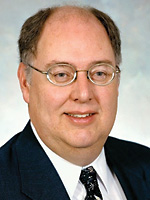
N. Wayne Hale, Jr.
Former Space Shuttle Program Manager and Flight Director In recognition of his exceptional contributions as a NASA engineer and manager, especially in increasing the safety of the space shuttle program If you remember the role Ed Harris played in the movie “Apollo 13,” you can easily picture what Wayne Hale did while serving as a flight director at NASA. For 15 years, Hale oversaw flights in Mission Control, and if things went wrong, he helped lead the team that came up with a solution. “On one mission, rainwater had gotten into one of the hydraulic systems and we were afraid it was going to turn to ice,” Hale says. “We had to prepare for not having full hydraulics for the landing. This also meant the shuttle couldn’t take much wind, so we had to make sure we chose a calm day for the landing.” Hale supported 41 space shuttle missions during his time in the Flight Director Office – a period he calls the highlight of his more than three decades at NASA. Missions involved periods of intense activity as well as long stretches of quiet. They also involved dealing with cultural differences. “You have to be somewhat of a diplomat,” says Hale. “Seventeen different countries are involved in the international space program. I remember on one mission there were Americans, Russians, Canadians and Japanese. It was an interesting experience.” Hale notes that by the late 1990s, the space shuttle had been around long enough that staff began to view it as a known quantity with no surprises in store. The Columbia disaster in 2003 served as a wake-up call. Shortly after the tragedy, Hale was one of the leaders tasked with improving NASA’s safety culture. “We instituted a policy of encouraging dissent, so that people who had concerns would bring them forward,” he says. “We also made our managers begin to listen more than talk, to seek to understand what staff members were saying rather than being dismissive and in a hurry.” In 2005, Hale became manager of the entire Space Shuttle Program, which had a budget of just over $5 billion and a staff of around 20,000. Hale was charged with safe and efficient management of the program and served in this role for three years. After such an eventful career, it’s perhaps no surprise that Hale has stayed active since retiring in 2010. His new goal is to help the commercial human space flight industry. He’s currently serving as a consultant to one of the companies in the industry, Special Aerospace Services of Boulder, Colo. “In my retirement, I intended not to sit in a rocking chair,” he says. “But my schedule is more flexible now. Sometimes I take a day off and take my grandkids to the zoo. It’s a lot of fun.” Career Highlights
|
